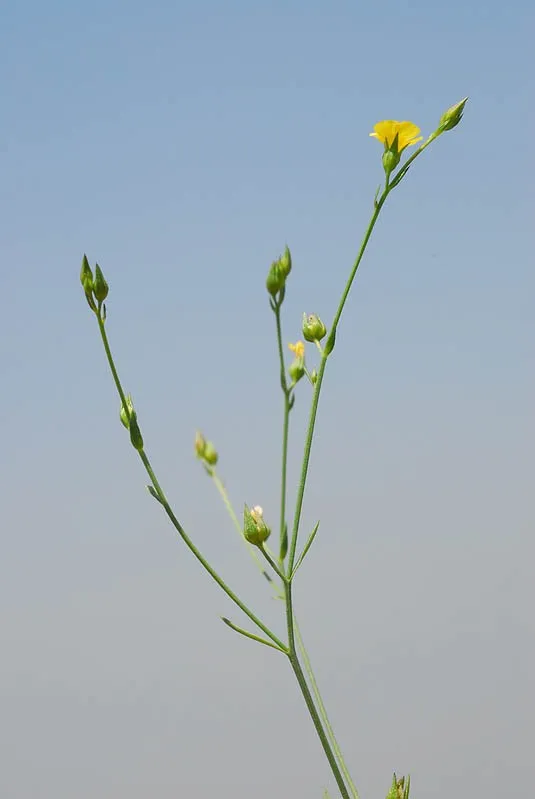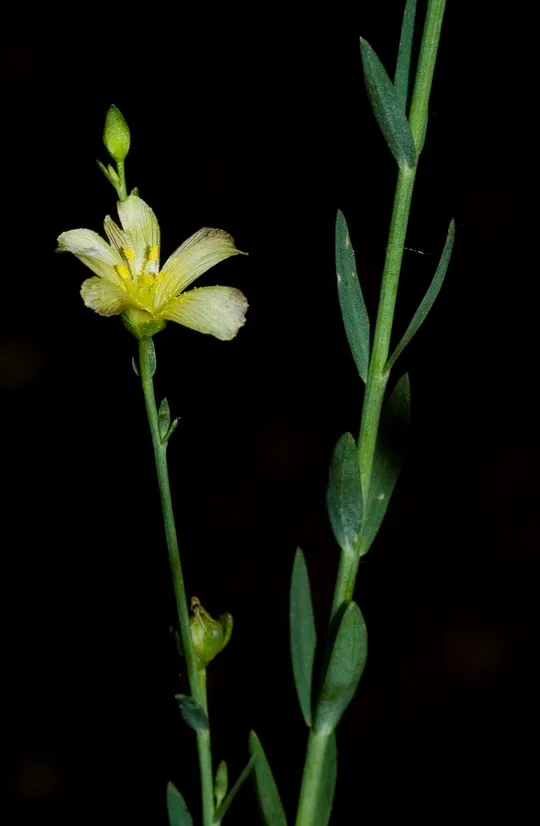French Flax, Southern Flax
Linum trigynum


Linum trigynum grows on two
adjacent sites in the lower Hermon – Mount Keta and Maǧdal Shams. In the spring
of 1983, it was reported from Eastern Ilanot in the Sharon, but its
identification is questionable.
Linum trigynum grows in Israel
and Lebanon on Nubian sandstone, but in Turkey and in other areas of the
Mediterranean it grows on arid herbaceous slopes; in Cyprus, for example, it
grows on serpentine and in Turkey in chalk garrigues. Perhaps the common link
between the L. trigynum habitats is the
low level of competition that is characteristic of habitats with inferior soil
conditions that have a sparse vegetation cover. This could explain the
differences between the main population growing on sandstone on Mount Keta and
the small population growing on the marly slope of Hill 1166 in Maǧdal Shams.
The genus Linum is a temperate subtropical genus
that consists of about 180 species, whose distribution center is in the
Mediterranean region. Thirty-six species grow in Europe and 38 in Turkey, the
greatest number of species in any country. L. trigynum belongs to the Linastrum
section in the genus Linum. Additional species in this section in
Israel include L.
strictum and L. corymbulosum.
These are annual species with tiny yellow
flowers and glabrous alternate leaves without glands on their stipules, which
do not form a rosette at the base of the plant; the calyx is pointed and the petals
are separate or partially fused. L. corymbulosum differs from L.
trigynum by its
branched panicle inflorescence. L. strictum is quite similar to L. trigynum, but differs from it by its
coarse leaves, rigid stems and its dense inflorescence with larger flowers.
Apparently, all the species of this section in Israel are almost obligatory self-pollinators,
a phenomenon related to their tiny flower, and their lack of heterostyly as
found in the Linum species with large, attractive flowers (e.g. L.pubescens
and L.mucronatum). In the heterostylous species,
the flowers in part of the population have a style that is higher than the
stamens, while in others, the stamens are higher than the style. This
morphological difference has a genetic basis, to prevent self-pollination,
because fertilization can occur only between pollen and stigma from stamens and
style of the same height, i.e. between different plants. Linum
species with small flowers
(L. strictum, L. corymbulosum and L. trigynum) on the other hand, are not
heterostylous and self-pollinate, which is related to the small dimensions of
the flower, reducing display and decreasing the distance between the anthers and
the stigma.
L.
trigynum is most similar to a common annual European species – L. catharticum. The two species are almost
identical in all characteristics but L. catharticum
has a white flower with a yellow base. This species is common in Europe in
disturbed habitats. Both species are adapted to seasonal habitats, they mainly
self-pollinate, grow rapidly and almost all their seeds ripen. It is possible that
L. trigynum is the source species of L. catharticum, as
L. trigynum
grows in a natural primary Mediterranean habitat, while the European species grows
in temporary disturbed habitats in areas covered in snow in the winter.
·
Linum trigynum grows only in
one region on two sites, and was observed only twice. There is no updated information
on changes in the condition of these sites and the population sizes.
·
Sandstone areas at the foot of Mount
Hermon are vulnerable to development (particularly agriculture) that threatens L. trigynum populations.
·
The population on Mount Keta is
located within the Hermon Nature Reserve.
·
L. trigynum has a relatively broad distribution
in the world and does not appear in Red books or lists, with the exception of
the Carpathian Mountains, where the species is classified as "Vulnerable"
(VU).
A thorough survey
should be conducted regarding the location, size and fluctuations of the Linum trigynum population at the
foot of Mount Hermon near Nimrod. The existence of L. trigynum in Ilanot should be verified.
The man distribution of Linum trigynumis is in the Mediterranean Basin: North Africa, southern Europe,
Cyprus, Lebanon, western Syria, Turkey, and northern Iran. According to the list
of Middle Eastern wild species (Conspectus Florae Orientalis), the species also
grows in northern Arabia and in the Eritrean-Arabian sub-region.
Linum trigynum is an extremely
rare annual plant that grows on only two sites at the foot Mount Hermon, in a
sandstone habitat that is vulnerable to development. The information regarding
its populations is incomplete.
Current Occupancy Map
| 1000 squre meter pixel | 5000 squre meter pixel | 10000 squre meter pixel | |
|---|---|---|---|
| number of observations | 0 | 0 | 0 |
| in total pixels | 0 | 0 | 0 |
| Family | Linaceae |
| Classification | On the endangered species list |
| Ecosystem | Mediterranean |
| Chorotype | Mediterranean |
| Conservation Site | Mount Keta at the foot of the Hermon |
| Rarity |
1
5
6
|
|---|---|
| Vulnerability |
0
1
4
|
| Attractiveness |
0
0
4
|
| Endemism |
0
0
4
|
| Red number |
1
3.7
10
|
| Peripherality | N |
| IUCN category | DD EW EX LC CR EN VU NT |
| Threat Definition according to the red book | Vulnerable |
 Based on:
Based on:






